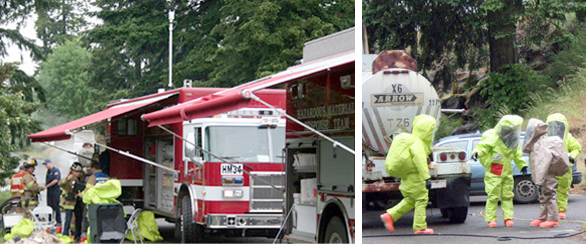HazMat Weather Part II: Weather Monitoring as a Force Multiplier

In Part I we discussed the ways weather factors can influence HazMat incidents. In this issue, we’re focusing on optimizing the weather monitoring capabilities as an integral component of the HazMat response team.
Planning
In contingency planning, weather conditions play a major role in any scenario – from the initial approach to the scene, to coordinating staging areas, to the actual mitigation process. Prior to deployment, a HazMat team member could be designated as the “weather coordinator.” The CAMEO/ALOHA software technician is a logical choice because they use the weather station’s data and have access to the Incident Commander.
The weather coordinator and other team members should be well-trained in the weather station’s operation, set up, and take down procedures. The weather station’s quick set up and operation is paramount to the initial mitigation process. These responsibilities can be easily incorporated into training programs and deployment responsibilities.
Weather Data Dissemination
In this day and age of interoperability, new innovations have made it feasible to disseminate on-scene weather information to multiple using agencies. Many mobile command vehicles have satellite links, wireless Internet, and wireless Local Area/Wide Area Network (LAN/WAN) services available.
It’s now possible to provide real-time weather readings to all echelons of command, whether at the scene, or not. It’s also possible to have multiple on-scene agencies receive official weather readings from a single weather station, rather than have multiple agencies with various different weather stations providing conflicting information. Such confusion could result in misinformation and/or casualties.
Procedures should to be in place to disseminate weather information during an incident – both up and down the chain of command. In addition to incorporating weather data into the CAMEO/ALOHA software, the Incident Command and emergency technicians should be notified of initial and changing weather conditions throughout the incident.
All team members and upper echelon leaders should be made aware of weather monitoring capabilities and reporting procedures.
HazMat Response
In staging a HazMat incident response, primary weather concerns are wind direction and speed. Operations should be staged from an upwind position. Once Incident Command has been established with weather monitoring in place, weather readings help identify the approach route for arriving responders, help determine the type of mitigation plan, and provide an evacuation corridor for victims and evacuees.
Site, elevation, and sun data are entered into CAMEO/ALOHA, as well as the type, quantity, source, and character of the chemical spill. This creates a chemical plume dispersion plot – or plume model – determining the toxic cloud’s width and distance downwind.
However, CAMEO/ALOHA does not provide a preliminary dispersion plot or provide vector wind data during the initial stages; it may take up to an hour to determine the downwind fallout area. WeatherMaster’s new vector wind and downwind projection plots use current conditions to project an initial plume corridor for immediate evacuation of the potential contamination area. In this way WeatherMaster acts as a force-multiplier – freeing up human resources and providing vital information in the Incident Command’s decision-making process.
Working Conditions
Triage
When accidents or incidents involve casualties, emergency personnel must triage victims in order to use the limited resources where they will do the greatest amount of good. Triage by definition, is a system of medical or emergency aid established to ration limited medical services to care for the greatest number of patients as possible.
Triage areas may be set up anywhere and initial resources may not be readily available. Water, shelter from the elements, and medical supplies may be immediately critical to victim survival. Depending on the circumstances, knowing the weather conditions can play a vital role in dispensing resources and providing back up medical assistance necessary to save lives.
Air Evac Operations
Hand-in-hand with triage and mass casualty situations, emergency medical airlift evacuation (Air Evac) operations may be necessary to quickly transport critical patients to local hospitals and medical facilities. On-scene weather readings becomes crucial in providing aircrews with real-time weather data to help with aircraft lift computations, entry/exit route strategies and flight path calculations, plus aiding in aircraft safety issues.
Heat Illness
Weather conditions also play a major role in managing emergency resources, including first responder and firefighter safety.
During high temperature conditions, Heat Stress, Heat Exhaustion, and Heat Stroke are primary threats to emergency responders.
HazMat suits do not allow for fresh air circulation and Personal Protective Equipment (PPE) can become extremely uncomfortable in searing heat. Heat Exhaustion not only neutralizes the responder, it also occupies the personnel who rescue them taking them away from operational tasks.
WeatherMaster’s alarm notification program monitors Heat Stress Index and then alerts when user-defined thresholds are breached, notifying decision-makers to take the necessary precautions to keep emergency personnel from becoming victims of Heat Illness.
Work/Rest cycles are also established based on Heat Stress conditions to keep on-scene personnel ready for duty. Under extreme Heat Stress conditions, first responders may work only 20 minutes per hour while drinking as much as two quarts of water to keep hydrated and sweating as much as one and a half to two quarts per hour.
Optimizing the HazMat Weather Monitoring
In conclusion, the following steps can optimize weather-monitoring capabilities for HazMat response and mitigation:
1) Identify potential weather-related risks
· Site selection upwind from the scene at a safe distance
· Determining points of entry to the scene
· Establishing staging areas for incoming crews
2) Designate a weather coordinator to assist the Incident Commander in monitoring weather conditions
3) Establish procedures for:
· Weather station set up, take down, and operations
· Interface with CAMEO/ALOHA
· Disseminating weather information to all echelons of command
· Operating under extreme or hazardous weather conditions
4) Notify team members and leaders of weather monitoring capabilities and procedures
5) “Training is the key to preparedness and preparedness is the key to success.”
return to top
|

